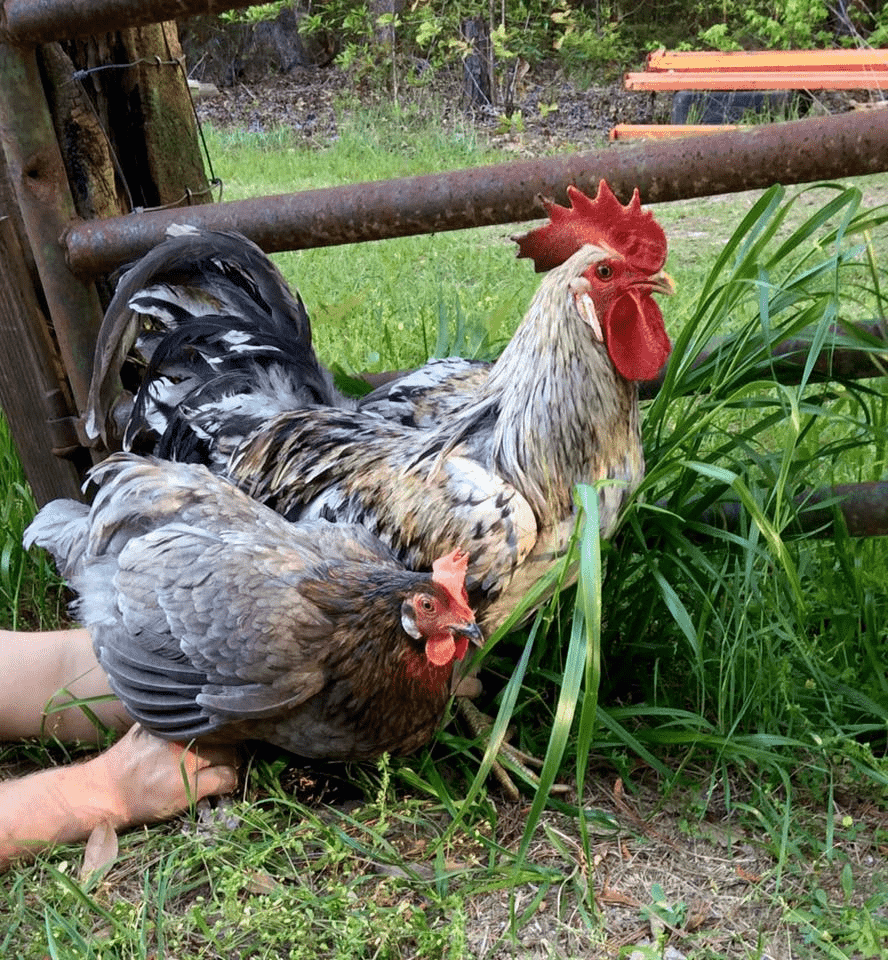Here’s what to know about raising an Olive Egger chicken. Hens begin laying when they are around 5 months old, and each hen can lay 175 eggs in a year. Olive Egger chickens are a cross between a brown egg layer and a blue egg layer. They are medium in size. At the end, I discuss sexing Olive Egger chicks.
Olive Egger chickens are hybrids that mix Legbars, Ameraucana, and Maran chicken breeds. While mixed-breed chickens aren’t uncommon, these egg layers are special for a few reasons. The most notable is that Olive Egger hens produce olive-colored eggs.
If you are looking to get into raising chickens but are unsure which to start out with, an Olive Egger chicken can be a good option to consider. If you want to hatch fertile eggs, you will also need a rooster.
Here’s a quick look at Olive Eggers, their origin, their history, and some reasons you might want to give raising them some serious consideration.
Olive Egger Chicken Facts
- Number of eggs per year: 150 to 200
- Number of eggs per lifetime: Up to 500
- Egg size: Large-sized eggs
- Egg color: Varies greatly depending on the bird’s parentage. It could be anywhere from olive green, blue, brown, and pink
- Number of eggs per week: 4 – 5
Origin and History Olive Egger Chicken
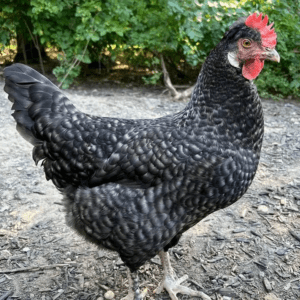
Technically not a breed recognized by the American Poultry Association in their own right, Olive Egger chickens are a hybrid that occurs when you crossbreed a blue egg layer with a dark brown egg layer.
For example, suppose you had eggs from a blue egg layer like the Blue Ameraucana chicken breed fertilized by a rooster with dark brown egg parentage such as the Marans rooster. In that case, the resulting chick will be an Olive Egger. If it’s a hen, it will lay olive green eggs. This kind of chick, even though it will hatch from the blue egg produced by the Ameraucana hen, will possess traits from both its parents.
Some blue egg layers that can successfully hatch an Olive Egger include:
- Ameraucana chicken
- Araucana chickens
- Cream Legbar chickens
Some brown egg layer chickens that can produce an Olive Egger include:
- Marans
- Penedesenca
- Empordanesa
- Welsummers
- Barnevelder
The crossbreeding between these chicken breeds has not happened recently. The craze for multi-colored eggs began in 1842 when a few Chinese chicken breeds were transported to England. Once in the country, these chickens were crossbred with the local chicken breeds, to the great bemusement of the local farmers.
Thanks to the resulting hens that produced exciting-colored eggs, more and more experiments were done amongst a host of other breeds until the Olive Egger breed was achieved and stabilized. Another one of these hybrids is the Prairie Bluebell Egger which lays blue eggs.
Olive Egger Chicken Characteristics and Appearance
Again, Olive Eggers aren’t a specific breed of chicken but a crossbreed between a blue egg layer and a brown egg layer chicken. Since numerous breeds fit both breed profiles, the resulting Olive Egger will vary in appearance from others unless they are from the same parentage.
As a result, you will often find that some Olive Eggers have features such as feathered legs, pea combs, and even muffs, while others don’t have these features. You will also find various plumage colors, making their appearance exceptionally unpredictable and just as exciting as their olive-colored eggs.
Color
However, if a breeder is determined to have a specifically colored Olive Egger chicken flock, they can find the right parents to crossbreed.
For example, a chicken keeper wanted to have Olive Eggers with a solid black color, they could try crossing a Black Ameraucana with a Black Copper Marans; this often results in chicks with solid black colors with maybe some Ameraucana cheek puffs.
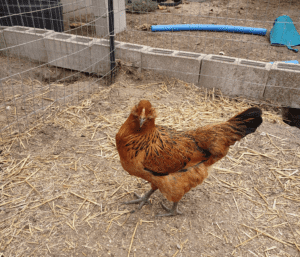
Weight
Olive Eggers are considered medium-sized chickens. They tend to have stocky bodies, with the Olive Egger roosters weighing in at about 7 – 8 pounds while the hens weigh in at about 6 – 7 pounds. This means even though they can be used for meat, they don’t produce that much. At least not as much as other breeds, such as the Brahma chicken. You can cull unproductive hens for meat along with any males you don’t want to raise.
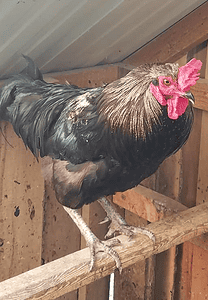
Egg Production
Olive Eggers are often raised as egg layer chickens instead of as meat or dual-purpose chickens. As the name suggests, these hens are valued for the green colored eggs that they produce.
Olive Eggers tend to produce olive green eggs, but the color of the eggs may vary depending on the breeds that go into making the hen in question. Sometimes, you will find hens that produce green, brown, blue, and even pink eggs.
That’s one of the main reasons these chickens are often fondly referred to as Easter Eggers. Crossing two breeds of anything isn’t always 100% predictable. That’s why you will often find Olive Eggers with different color feathers.
The kinds of eggs they produce are interesting. While the outer eggshell color may be any odd color, the inside of the shell is almost always bright green. The outside of Olive Egger eggs often look brown but have a translucent coating.
The eggs that have a green shade often vary as well. The shade can be anywhere from a bright green to a brown hue, making these some of the best options for your Easter egg basket.
Olive Egger chickens are excellent egg producers. A healthy hen can lay up to 200 eggs yearly, giving you 4 – 5 eggs weekly. They start laying at about 5 or 6 months old, relatively later than most other prolific egg-laying breeds.
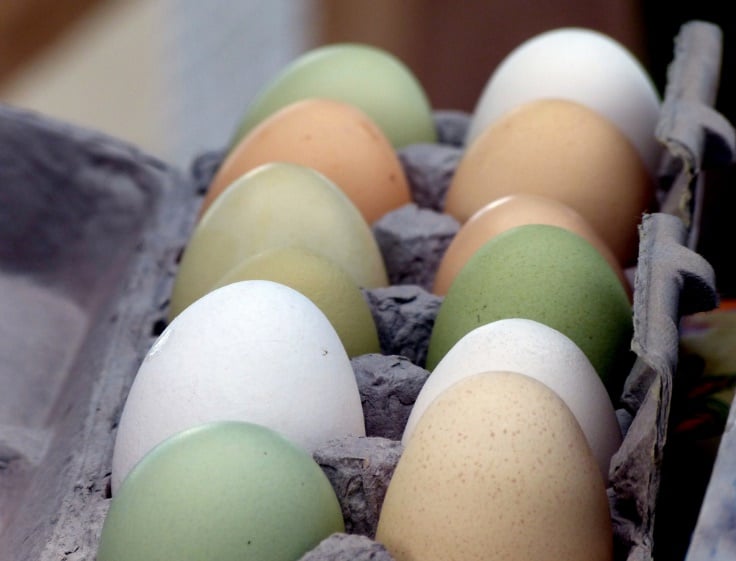
The right Olive Egger hen will produce large-sized eggs consistently. Some farmers believe you get better layers when the Olive Egger hen has the Ameraucanas breed in their blood.
Olive Egger hens have been known to be quite broody and decent mothers that take very good care of chicken eggs and Olive Egger chicks. Their broodiness, just like their temperament, depends on their parentage. In general, they are broody since Olive Eggers come from heritage breeds.
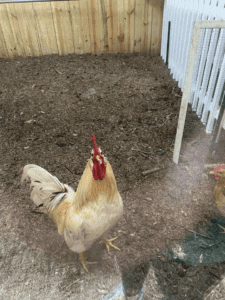
Olive Egger Chickens Personality and Temperament
If the plumage and egg color produced by Olive Eggers vary depending on their parentage, it stands to reason that their personalities and temperaments would vary too. While this is true, the fact is that these birds are generally quite friendly and docile despite their parentage. Only the degree varies.
Much like plumage, the best way to determine how friendly or docile the resulting bird will be is to look at its parents. If you pair parents with a good disposition with a docile nature, then there’s a good chance you will end up with a friendly flock of baby chicks.
Breeders have taken to pairing the kinds of parents they want their chicks to emulate. For example, chicken farmers who want a more intelligent and inquisitive flock tend to go for baby chicks with Welsummer parentage.
That being said, some poultry breeders or farmers have found Olive Eggers with Maran’s parentage standoffish, while those with Ameraucanas parentage have been noted as skittish.
This mixed breed of chicken is generally friendly and docile, making it one of the best to have on a backyard farm. They play nice with the other chickens that are part of the flock and are also usually safe to leave around children. Even the roosters have proven to be quite docile.
Why Raise Olive Egger Chickens?
You might want to consider raising Olive Egger chickens as part of your backyard flock for several reasons.
Egg Production
Egg production is the primary reason this chicken breed is bred in the first place. Olive Eggers are excellent layers that produce up to 200 eggs per year.
Farmers with children will find these birds particularly useful around Easter as they can use their colorful eggs as part of their Easter baskets. Another reason would be commercially oriented.
If you are selling eggs for eating, Olive Egger eggs sell for a bit more per dozen than typical white eggs. If you are selling fertile eggs to hatch into chicks, it’s not uncommon to sell a single egg for at least $6. Because one hen can lay up to 200 eggs per year, any farmer with a robust flock stands to make quite a bit of money just from selling the eggs.
Friendly Disposition
These birds are quite friendly and easy to manage. Although they can forage for their own food, it’s best to provide them with the right kind of feed to ensure that they keep producing as many eggs as possible. The fact that these birds are quite friendly and personable makes them ideal pets that can be raised around children.
Hardiness
Olive Eggers are hardy and can withstand a wide range of temperatures, from cold to extreme heat. This is yet another factor that is affected by parentage. If you crossbreed birds that tend to do well in cold temperatures, the offspring are most likely to be cold-hardy.
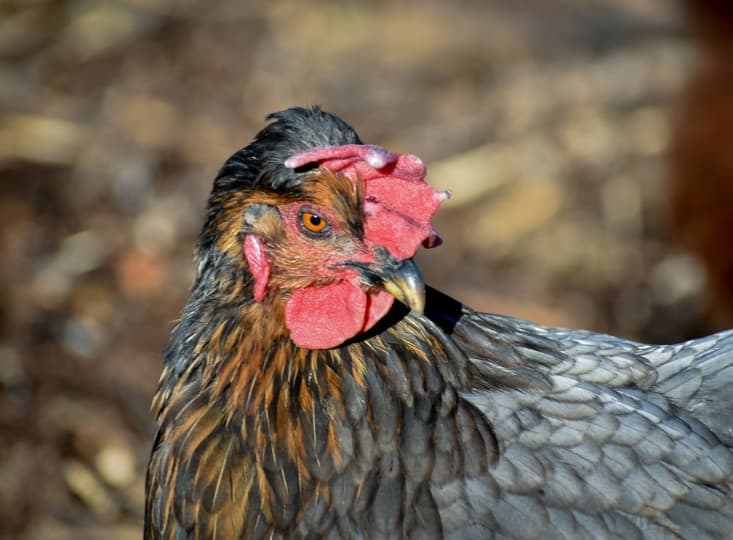
Even though they are not known for their meat production, Olive Egger roosters have a bit of meat on them, and they can be used for meat if need be, but not commercially.
Raising Olive Egger Chickens
They have a friendly and docile persona, making them excellent for first-time farmers and kids, and they are also quite profitable in terms of egg production.
While the egg color depends on the bird’s parentage, it would be interesting to see what you can come up with by pairing different parents in your backyard. That makes the Olive Egger a rather profitable and enjoyable experiment in crossbreeding.
Sexing Olive Eggers
Whether you raise a rooster alongside your hens determines if they hens lay eggs that can hatch into chicks. These are considered to be fertile eggs. If you want to raise chicks from eggs, you may choose to buy eggs from a hatchery and incubate and hatch them at home. Or you may have fertile eggs and you want to know if they are females or males.
Most often, flock owners are hoping for egg-laying hens (the females) and not roosters (the males). Sexing chicks is the process of determining if they are females or males after they hatch. Once their sex is determined, female chicks are called pullets, and the male chicks are called cockerels.
Sexing olive eggers is a process that can be done shortly after hatching. Here are some key things to keep in mind when identifying the gender of your olive eggers:
- Olive Eggers are auto-sexing, which means that you can determine their gender right after they hatch.
- Male chicks may have a white dot on the top of their head that females do not have.
- Initially, all chicks will appear black in color.
- Female chicks will have alternating long and short pin feathers on their wingtips, with the longer pin feathers identifying them as females.
- Female Olive Eggers grow feathers at a faster rate than males during their first few weeks of life. (If you have a cockerel in your brood, you can compare their rate of feather growth.)
By paying attention to these physical indicators, you can determine the gender of your Olive Eggers to see how many eventual hens vs roosters are in your brood.
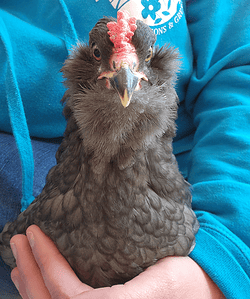
FAQs
Is my Olive Egger a rooster?
How can I tell if my Olive Egger is a rooster? Olive Egger roosters, unlike most other roosters, may or may not have a crest, making it quite difficult to tell outright. Female chicks grow feathers more quickly than their male counterparts within the first couple of weeks. If you have a cockerel in your brood, you may be able to tell the difference by comparing feathers.
Another way of sexing Olive Eggers is to look at their wingtips after 12 hours of hatching. At this point, the chicks tend to have alternating short and long pin feathers. The males will have short pin feathers, while the females will have long pin feathers.
Although, if you pair a Black Copper Marans with a Cream Legbar, you can easily sex the chicks at hatching since the males tend to have peculiar white dots on their heads. The females will either have black feathers with a bronze shade or solid black with a crest.
Do Olive Eggers have any health concerns?
Being naturally hardy birds, Olive Eggers hardly have any health issues. It is, however, important to pay close attention to the specific bird’s parentage to be sure. That being said, these birds tend to have thick plumage, which is often infested by mites and chicken lice.
These parasites tend to suck the blood from the chickens, making them weak and prone to infections. However, this problem can easily be solved by dusting diatomaceous earth powder.
How long do Olive Egger chickens live?
Chicken lifespan for Olive Eggers is typically 5 – 8 years with proper care, including fresh water daily, the right nutrients, protection from predators, and keeping them stress-free with other even-tempered chickens. If you keep a rooster alongside Easter Eggers, be sure to have 8 – 10 hens per rooster which will minimize stress for the hens.
Whether raised in backyards as beloved pets or purely for utility for their colorful eggs and meat as a bonus, you will enjoy this easy-to-raise breed.
What is the difference between Olive Eggers and Easter Eggers?
Their parents will determine whether they are Olive Eggers or Easter Eggers. You know if you have an Olive Egger because the hens lay green tinted eggs also considered olive in color.

